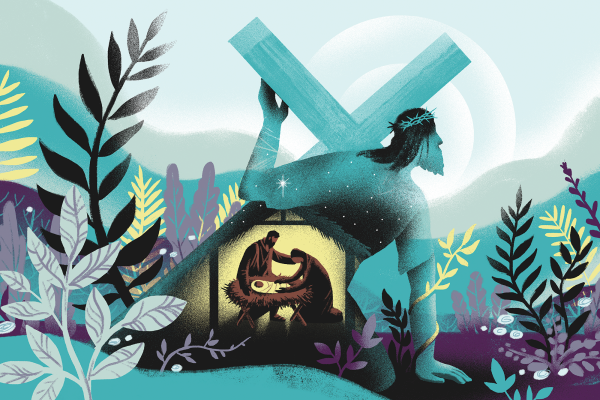ON SUFJAN STEVENS' 2012 Christmas album, Silver & Gold, he includes “Ah Holy Jesus,” a hymn about Christ’s crucifixion. Stevens sings: “For me, kind Jesus, was thine incarnation / thy mortal sorrow, and thy life’s oblation / thy death of anguish and thy bitter passion / for my salvation.” The cross on Golgotha casts a long shadow toward Bethlehem. When the child in the manger grows into adulthood, our world kills him. The story of the incarnation is the story of crucifixion.
For Stevens to sing such a hymn during this season reminds us that Jesus was born into an anguished world—an anguish that took hold in his life, an agony unto death. “The whole life of Jesus comes under the heading ‘suffered,’” theologian Karl Barth commented. “For the evangelists Luke and Matthew, the childhood of Jesus, his birth in the stable of Bethlehem, were already under the sign of suffering,” Barth continued. “The entire life of Jesus is lived ... in the shadow of the cross.”
Jesus didn’t offer salvation as an escape plan from our life’s travails but as a commitment to heal us from the habits of sin, the violence that cuts through each of us and the world. Christmas Day doesn’t redeem our wounded world in an instant—as if the old order vanishes with the newborn’s first cry. Instead, Jesus undergoes a human life and entrusts our lives to the Holy Spirit’s care.
Salvation is a salve, the soothing presence of the Spirit. This same Comforter took care of Mary at Jesus’ birth and ministered to him during his passion. “For me, kind Jesus, was thine incarnation ... and thy life’s oblation.”
December 5
Prepare the Way
Malachi 3:1-4; Luke 1:68-79; Philippians 1:3-11; Luke 3:1-6
A SPIRITUALITY OF discipleship is an important theme in our Christian tradition. We practice imitatio Christi, conforming ourselves to Jesus. In this, Jesus becomes the model for our ethics, a way of life devoted to God. As a member of the Mennonite Church, I’m at home in this Anabaptist vision for Christian existence. “We cannot know Christ unless we follow him daily in life,” said Hans Denck, a 16th century German Anabaptist leader.
In Luke’s gospel, John the Baptizer invites us into a different posture in relation to Jesus, not to see ourselves as “little Christs,” or as reincarnations of Jesus, but to look to John as our exemplar. John is the witness. He is a sign that points to what’s emerging. John offers the baptism of repentance as a ritual of preparation to ready the people for the advent of the Messiah. As the prophet Malachi foretold, “See, I will send my messenger, who will prepare the way before me” (Malachi 3:1). John is the harbinger of the coming of the Lord. The author of Luke’s gospel quotes from the book of Isaiah to describe John’s ministry. John is the “voice of one crying out in the wilderness: ‘Prepare the way of the Lord’” (Luke 3:4).
We are like John. As a collective body, the church incarnates an announcement of the gospel. Congregations exist as communal proclamations of Christ’s advent. We bear witness to Jesus’ arrival in the world as we sing hymns and read our scriptures. We pray for each other and preach the good news—all our worship is a cry in the wilderness, to make a way for the mysteries of God among us.
December 12
Chaff and Wheat
Zephaniah 3:14-20; Isaiah 12:2-6; Philippians 4:4-7; Luke 3:7-18
“WHAT THEN SHOULD we do?” (Luke 3:10) the crowd demands of John the Baptist after he yells at them from the riverside, calling them to repentance and cleansing in preparation for the Messiah. “You brood of vipers!” John shouts. “Who warned you to flee from the wrath to come? Bear fruits worthy of repentance!” (verses 7-8).
John stuns the crowd—his prophetic zeal, intensity, and devotion to God’s righteousness shock the people gathered at the Jordan. John announces imminent judgment: “Even now the ax is lying at the root of the trees; every tree therefore that does not bear good fruit is cut down and thrown into the fire” (verse 9).
During Advent we are in the crowd along the river. John’s words crash through our lives. His pronouncements batter us like waves of judgment and hope, one after the other. We are left baffled about what this Messiah will mean for our lives. In the company of soldiers and tax collectors, we too ask, “And we, what should we do?” (verses 12, 14). John’s response centers on money, on the economics of grace, and on the redistribution of wealth and property. “Whoever has two coats must share with anyone who has none” (verse 11). “Do not extort money from anyone” (verse 14).
What then should we do? That’s the question at the heart of Advent. We remember that humanity rejected Jesus upon his arrival. Will we be different this time? This world couldn’t, wouldn’t, bear his life of love—a divine love that trembled the foundations of life. Jesus confronts us with the possibility of a world reborn, of being set free from sin. If we are to prepare for the new life Christ offers, then it will involve a threshing. As John says, we must separate chaff from wheat in our lives.
December 19
Fullness of Time
Micah 5:2-5; Psalm 80:1-7; Hebrews 10:5-10; Luke 1:39-55
ONE OF THE mysteries of Advent is timing: Why was Jesus born at that particular moment in history? And why Mary? The Advent stories are full of bewilderment. Mary asks the angel Gabriel, “How can this be?” (Luke 1:34). When Elizabeth sees the pregnant Mary, she asks, “Why has this happened to me, that the mother of my Lord comes to me?” (verse 43).
The best explanations come from theologians who admit ignorance. We have no idea why God chose that time and place for the incarnation, other than that’s when God decided to do what God did. Thomas Aquinas writes in his 13th century Summa Theologica that Jesus was born in first-century Palestine because it was convenientia (fitting). The “fittingness” of Advent, because that was the timing that seemed right to God. The apostle Paul makes a similar theological point: “When the fullness of time had come, God sent his Son, born of a woman” (Galatians 4:4).
The fullness of time. Think of God, waiting century after century, overwhelmed with longing to draw closer to human beings—closer to you and me. During God’s long wait, love expanded in God’s heart, stretching to the point of bursting. Mary’s Magnificat (Luke 1:46-55) is what God’s heartbeat sounds like as the waiting draws to a close. Words bubble up from within her. Mary’s song is God’s tiny heartbeat translated into human language as prophecy. Mary proclaims what the advent of God’s love in the flesh will do in our world: the powerful cast down from their thrones, and the lowly lifted up; the hungry filled with good things, and the rich sent away empty (verses 49-55).
December 26
Fully Human
1 Samuel 2:18-20, 26; Psalm 148; Colossians 3:12-17; Luke 2:41-52
FOLLOWING MARY'S DELIVERY of Jesus in that Bethlehem stable, after the startling reality of God as a swaddled infant, after the astonishment of Christmas Day, then everyone returns to their routine. Joseph and Mary will dedicate years of daily rituals for the care of this child.
The biblical accounts of Jesus’ life pass silently over his childhood and adolescence. Luke’s gospel gives hints: “The child grew and became strong in spirit,” (Luke 1:80). The next chapter repeats the statement: “The child grew and became strong, filled with wisdom” (Luke 2:40). And again: “Jesus increased in wisdom and in years” (Luke 2:52). He grew and grew. Over the years Jesus learned the feel of time on his skin, the way growing pains feel in the body. He learned to become part of this world; how to love and how to mourn.
Imitatio Christi. To be like Jesus is to be human. According to the Chalcedonian Creed on the nature of Christ, Jesus was “fully human,” like us in all things but sin. That doctrinal claim, religion and culture professor Peter Dula writes, “makes us wonder, or should, if we are human.” Discipleship is a commitment to become deeply human, to grow into the humanity of Jesus—the one whose life was filled with “the grace of God” (Luke 2:40). To grow in grace is to welcome every breath with gratitude, to recognize this world as a gift.
Christianity is a collective style of life where we grow in our likeness to Jesus; discipleship is our participation in the humanity of Christ. To believe in the incarnation is to bear witness to God’s love for the world with our own lives and as a community. Discipleship is to become living signs of Christ—for God’s love to become our human flesh.

Got something to say about what you're reading? We value your feedback!

